Managing Change Strategies: A Report on Big W's Transformation
VerifiedAdded on 2022/11/25
|11
|2705
|111
Report
AI Summary
This report examines the change management strategies for Big W, an Australian department store chain facing significant challenges including store closures and declining profits. The report analyzes the context, forces of change (workforce, technology, competition, social trends), and key issues such as the inability to achieve desired profit levels and the need for organizational transformation. Proposed changes include a focus on customer centricity, loyalty programs, product mix pricing strategies, and the implementation of new technology. The report also identifies potential problems like budget constraints, conflicts, and resistance to change, and offers recommendations such as identifying change agents, communicating effectively, applying Lewin’s or McKinsey’s change models, and fostering a positive corporate culture. The report emphasizes the importance of leadership, employee skill development, and meeting corporate social responsibility criteria to ensure successful change management and business sustainability.
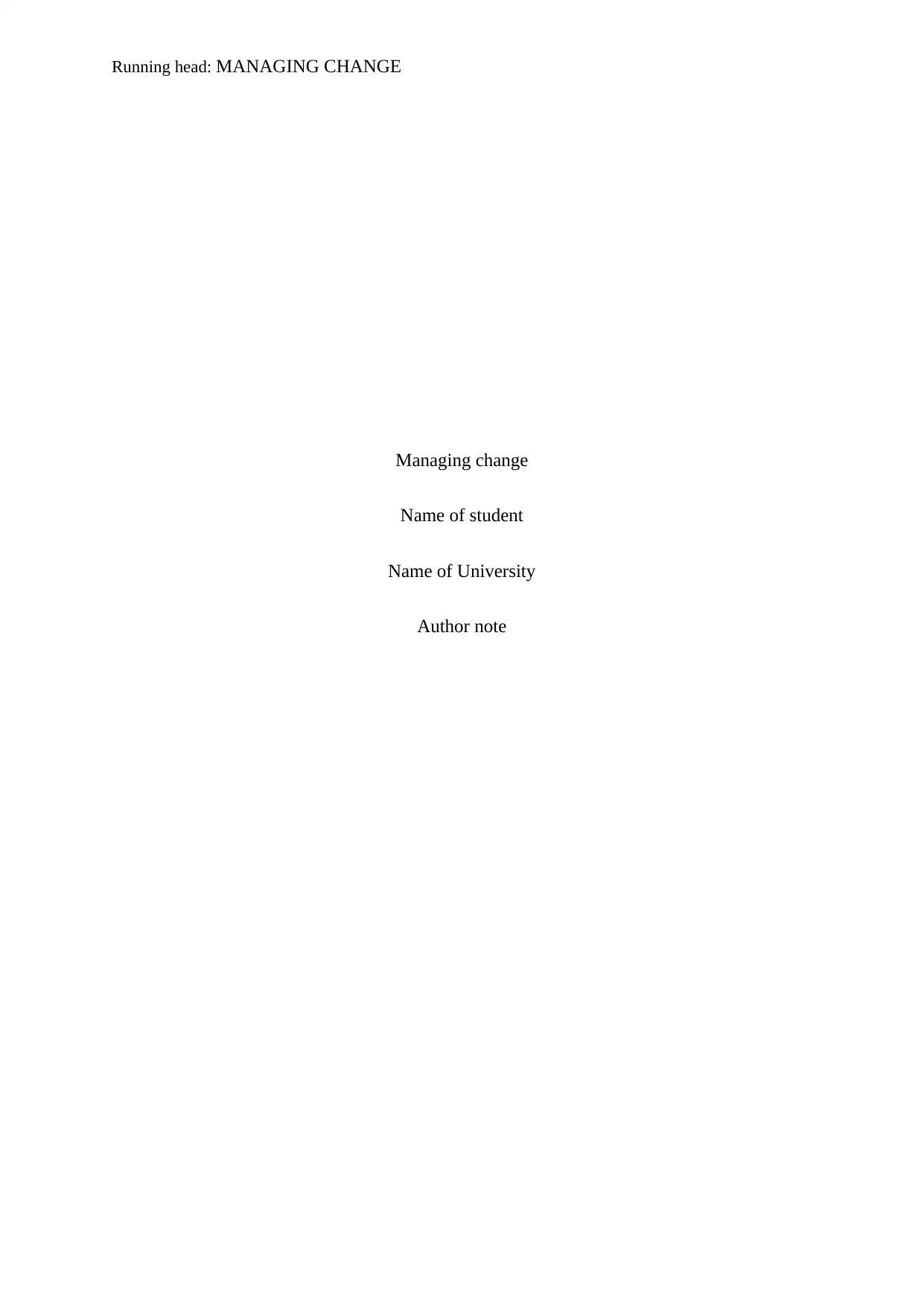
Running head: MANAGING CHANGE
Managing change
Name of student
Name of University
Author note
Managing change
Name of student
Name of University
Author note
Paraphrase This Document
Need a fresh take? Get an instant paraphrase of this document with our AI Paraphraser
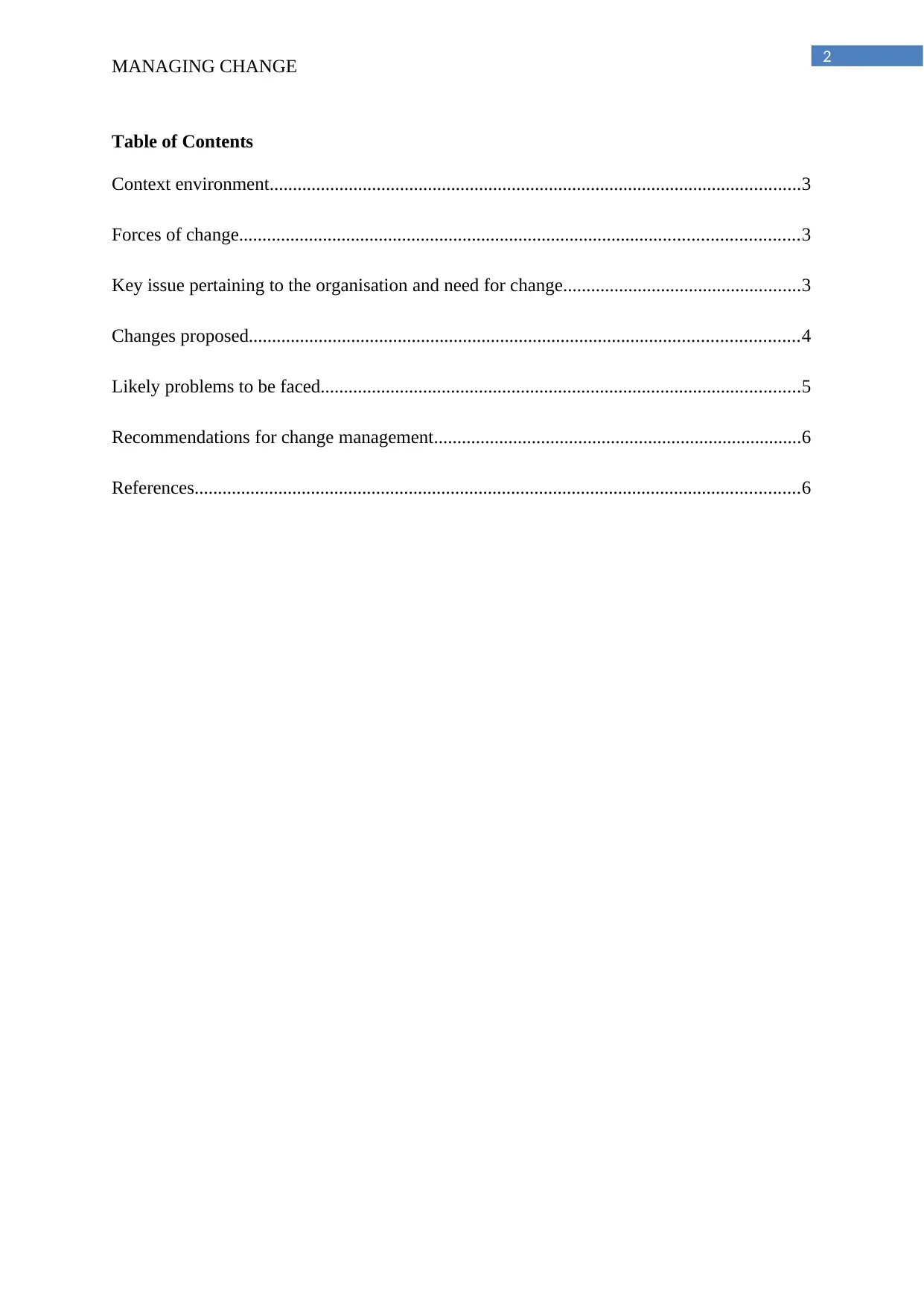
2
MANAGING CHANGE
Table of Contents
Context environment..................................................................................................................3
Forces of change........................................................................................................................3
Key issue pertaining to the organisation and need for change...................................................3
Changes proposed......................................................................................................................4
Likely problems to be faced.......................................................................................................5
Recommendations for change management...............................................................................6
References..................................................................................................................................6
MANAGING CHANGE
Table of Contents
Context environment..................................................................................................................3
Forces of change........................................................................................................................3
Key issue pertaining to the organisation and need for change...................................................3
Changes proposed......................................................................................................................4
Likely problems to be faced.......................................................................................................5
Recommendations for change management...............................................................................6
References..................................................................................................................................6
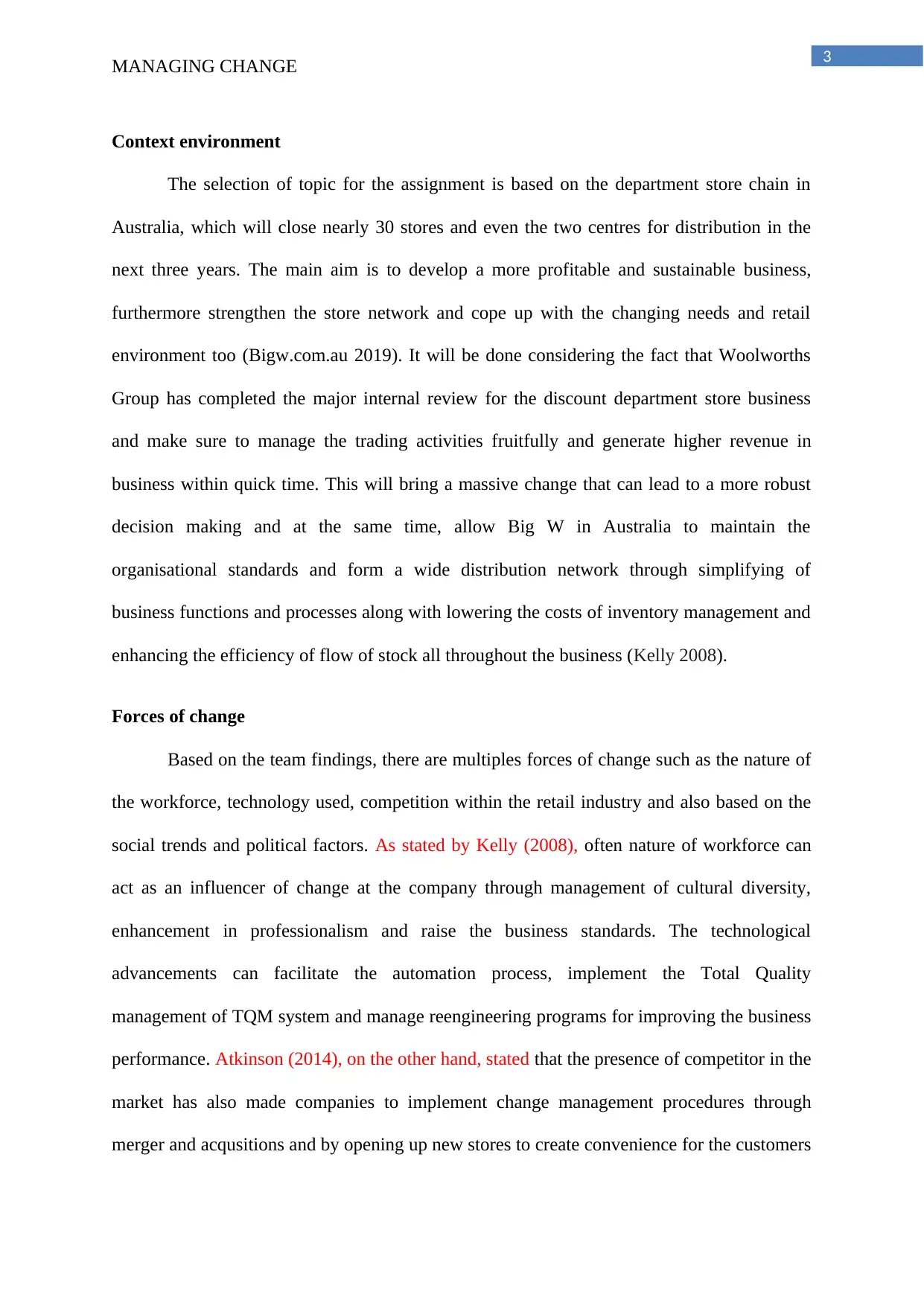
3
MANAGING CHANGE
Context environment
The selection of topic for the assignment is based on the department store chain in
Australia, which will close nearly 30 stores and even the two centres for distribution in the
next three years. The main aim is to develop a more profitable and sustainable business,
furthermore strengthen the store network and cope up with the changing needs and retail
environment too (Bigw.com.au 2019). It will be done considering the fact that Woolworths
Group has completed the major internal review for the discount department store business
and make sure to manage the trading activities fruitfully and generate higher revenue in
business within quick time. This will bring a massive change that can lead to a more robust
decision making and at the same time, allow Big W in Australia to maintain the
organisational standards and form a wide distribution network through simplifying of
business functions and processes along with lowering the costs of inventory management and
enhancing the efficiency of flow of stock all throughout the business (Kelly 2008).
Forces of change
Based on the team findings, there are multiples forces of change such as the nature of
the workforce, technology used, competition within the retail industry and also based on the
social trends and political factors. As stated by Kelly (2008), often nature of workforce can
act as an influencer of change at the company through management of cultural diversity,
enhancement in professionalism and raise the business standards. The technological
advancements can facilitate the automation process, implement the Total Quality
management of TQM system and manage reengineering programs for improving the business
performance. Atkinson (2014), on the other hand, stated that the presence of competitor in the
market has also made companies to implement change management procedures through
merger and acqusitions and by opening up new stores to create convenience for the customers
MANAGING CHANGE
Context environment
The selection of topic for the assignment is based on the department store chain in
Australia, which will close nearly 30 stores and even the two centres for distribution in the
next three years. The main aim is to develop a more profitable and sustainable business,
furthermore strengthen the store network and cope up with the changing needs and retail
environment too (Bigw.com.au 2019). It will be done considering the fact that Woolworths
Group has completed the major internal review for the discount department store business
and make sure to manage the trading activities fruitfully and generate higher revenue in
business within quick time. This will bring a massive change that can lead to a more robust
decision making and at the same time, allow Big W in Australia to maintain the
organisational standards and form a wide distribution network through simplifying of
business functions and processes along with lowering the costs of inventory management and
enhancing the efficiency of flow of stock all throughout the business (Kelly 2008).
Forces of change
Based on the team findings, there are multiples forces of change such as the nature of
the workforce, technology used, competition within the retail industry and also based on the
social trends and political factors. As stated by Kelly (2008), often nature of workforce can
act as an influencer of change at the company through management of cultural diversity,
enhancement in professionalism and raise the business standards. The technological
advancements can facilitate the automation process, implement the Total Quality
management of TQM system and manage reengineering programs for improving the business
performance. Atkinson (2014), on the other hand, stated that the presence of competitor in the
market has also made companies to implement change management procedures through
merger and acqusitions and by opening up new stores to create convenience for the customers
You're viewing a preview
Unlock full access by subscribing today!
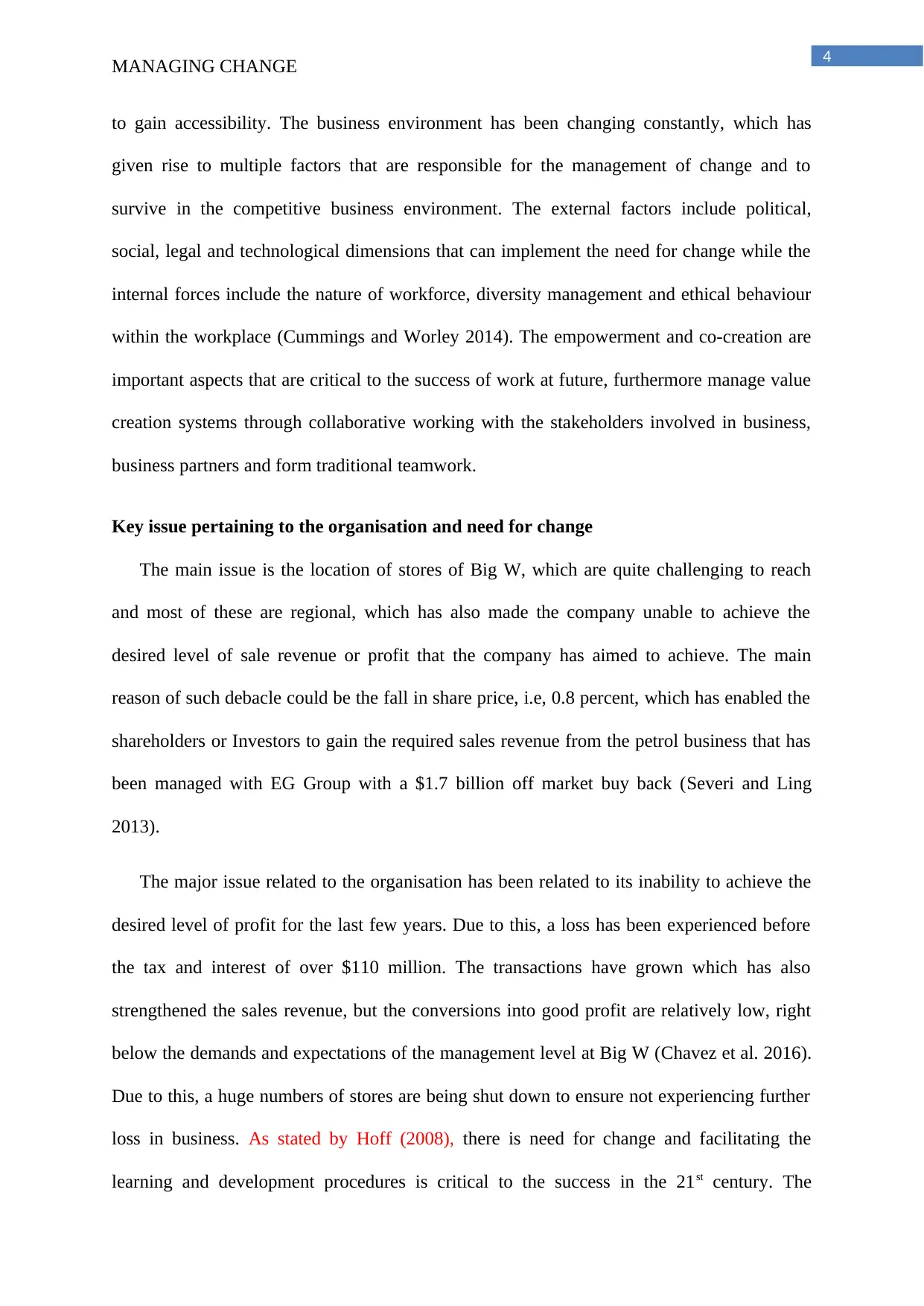
4
MANAGING CHANGE
to gain accessibility. The business environment has been changing constantly, which has
given rise to multiple factors that are responsible for the management of change and to
survive in the competitive business environment. The external factors include political,
social, legal and technological dimensions that can implement the need for change while the
internal forces include the nature of workforce, diversity management and ethical behaviour
within the workplace (Cummings and Worley 2014). The empowerment and co-creation are
important aspects that are critical to the success of work at future, furthermore manage value
creation systems through collaborative working with the stakeholders involved in business,
business partners and form traditional teamwork.
Key issue pertaining to the organisation and need for change
The main issue is the location of stores of Big W, which are quite challenging to reach
and most of these are regional, which has also made the company unable to achieve the
desired level of sale revenue or profit that the company has aimed to achieve. The main
reason of such debacle could be the fall in share price, i.e, 0.8 percent, which has enabled the
shareholders or Investors to gain the required sales revenue from the petrol business that has
been managed with EG Group with a $1.7 billion off market buy back (Severi and Ling
2013).
The major issue related to the organisation has been related to its inability to achieve the
desired level of profit for the last few years. Due to this, a loss has been experienced before
the tax and interest of over $110 million. The transactions have grown which has also
strengthened the sales revenue, but the conversions into good profit are relatively low, right
below the demands and expectations of the management level at Big W (Chavez et al. 2016).
Due to this, a huge numbers of stores are being shut down to ensure not experiencing further
loss in business. As stated by Hoff (2008), there is need for change and facilitating the
learning and development procedures is critical to the success in the 21st century. The
MANAGING CHANGE
to gain accessibility. The business environment has been changing constantly, which has
given rise to multiple factors that are responsible for the management of change and to
survive in the competitive business environment. The external factors include political,
social, legal and technological dimensions that can implement the need for change while the
internal forces include the nature of workforce, diversity management and ethical behaviour
within the workplace (Cummings and Worley 2014). The empowerment and co-creation are
important aspects that are critical to the success of work at future, furthermore manage value
creation systems through collaborative working with the stakeholders involved in business,
business partners and form traditional teamwork.
Key issue pertaining to the organisation and need for change
The main issue is the location of stores of Big W, which are quite challenging to reach
and most of these are regional, which has also made the company unable to achieve the
desired level of sale revenue or profit that the company has aimed to achieve. The main
reason of such debacle could be the fall in share price, i.e, 0.8 percent, which has enabled the
shareholders or Investors to gain the required sales revenue from the petrol business that has
been managed with EG Group with a $1.7 billion off market buy back (Severi and Ling
2013).
The major issue related to the organisation has been related to its inability to achieve the
desired level of profit for the last few years. Due to this, a loss has been experienced before
the tax and interest of over $110 million. The transactions have grown which has also
strengthened the sales revenue, but the conversions into good profit are relatively low, right
below the demands and expectations of the management level at Big W (Chavez et al. 2016).
Due to this, a huge numbers of stores are being shut down to ensure not experiencing further
loss in business. As stated by Hoff (2008), there is need for change and facilitating the
learning and development procedures is critical to the success in the 21st century. The
Paraphrase This Document
Need a fresh take? Get an instant paraphrase of this document with our AI Paraphraser
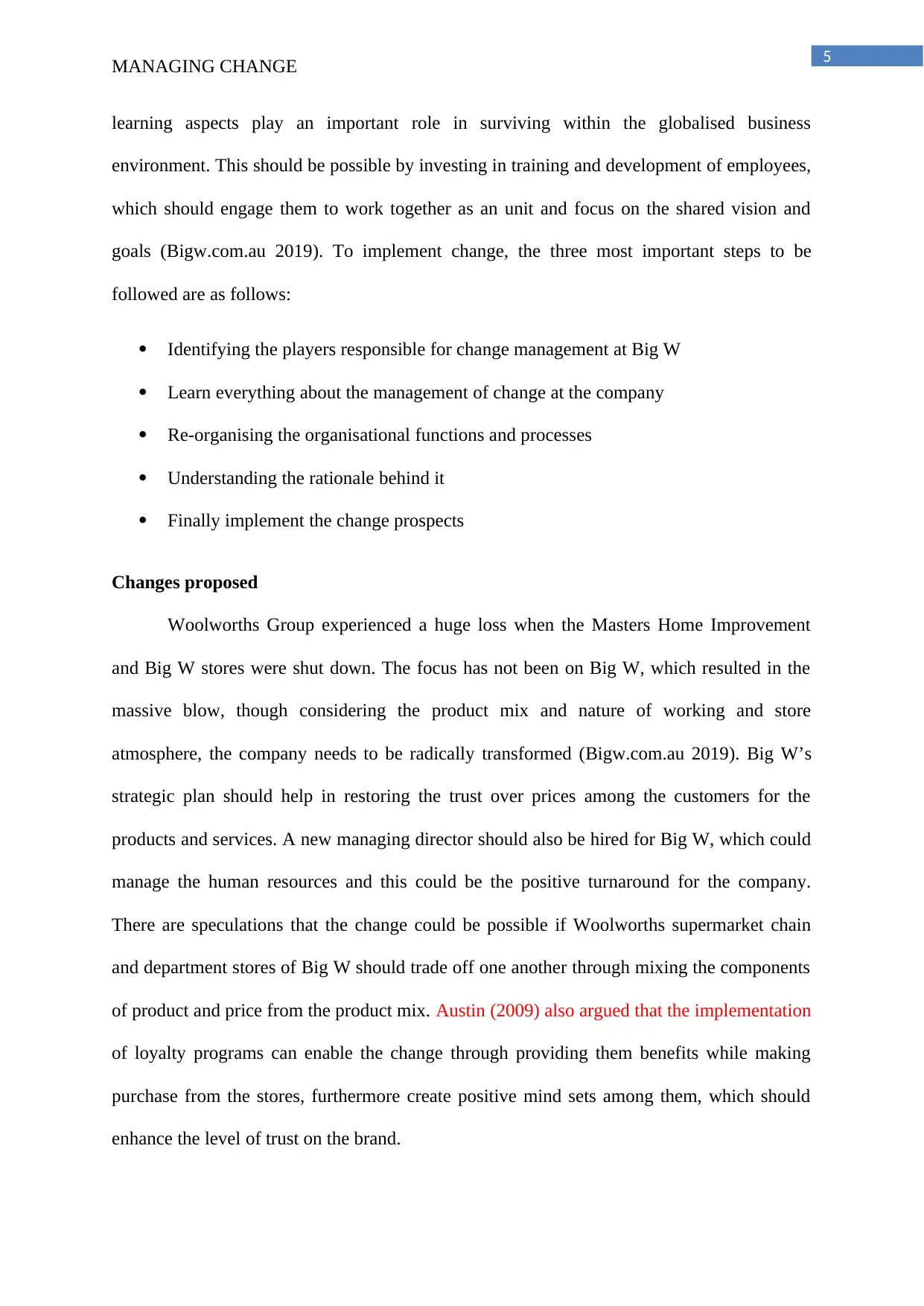
5
MANAGING CHANGE
learning aspects play an important role in surviving within the globalised business
environment. This should be possible by investing in training and development of employees,
which should engage them to work together as an unit and focus on the shared vision and
goals (Bigw.com.au 2019). To implement change, the three most important steps to be
followed are as follows:
Identifying the players responsible for change management at Big W
Learn everything about the management of change at the company
Re-organising the organisational functions and processes
Understanding the rationale behind it
Finally implement the change prospects
Changes proposed
Woolworths Group experienced a huge loss when the Masters Home Improvement
and Big W stores were shut down. The focus has not been on Big W, which resulted in the
massive blow, though considering the product mix and nature of working and store
atmosphere, the company needs to be radically transformed (Bigw.com.au 2019). Big W’s
strategic plan should help in restoring the trust over prices among the customers for the
products and services. A new managing director should also be hired for Big W, which could
manage the human resources and this could be the positive turnaround for the company.
There are speculations that the change could be possible if Woolworths supermarket chain
and department stores of Big W should trade off one another through mixing the components
of product and price from the product mix. Austin (2009) also argued that the implementation
of loyalty programs can enable the change through providing them benefits while making
purchase from the stores, furthermore create positive mind sets among them, which should
enhance the level of trust on the brand.
MANAGING CHANGE
learning aspects play an important role in surviving within the globalised business
environment. This should be possible by investing in training and development of employees,
which should engage them to work together as an unit and focus on the shared vision and
goals (Bigw.com.au 2019). To implement change, the three most important steps to be
followed are as follows:
Identifying the players responsible for change management at Big W
Learn everything about the management of change at the company
Re-organising the organisational functions and processes
Understanding the rationale behind it
Finally implement the change prospects
Changes proposed
Woolworths Group experienced a huge loss when the Masters Home Improvement
and Big W stores were shut down. The focus has not been on Big W, which resulted in the
massive blow, though considering the product mix and nature of working and store
atmosphere, the company needs to be radically transformed (Bigw.com.au 2019). Big W’s
strategic plan should help in restoring the trust over prices among the customers for the
products and services. A new managing director should also be hired for Big W, which could
manage the human resources and this could be the positive turnaround for the company.
There are speculations that the change could be possible if Woolworths supermarket chain
and department stores of Big W should trade off one another through mixing the components
of product and price from the product mix. Austin (2009) also argued that the implementation
of loyalty programs can enable the change through providing them benefits while making
purchase from the stores, furthermore create positive mind sets among them, which should
enhance the level of trust on the brand.
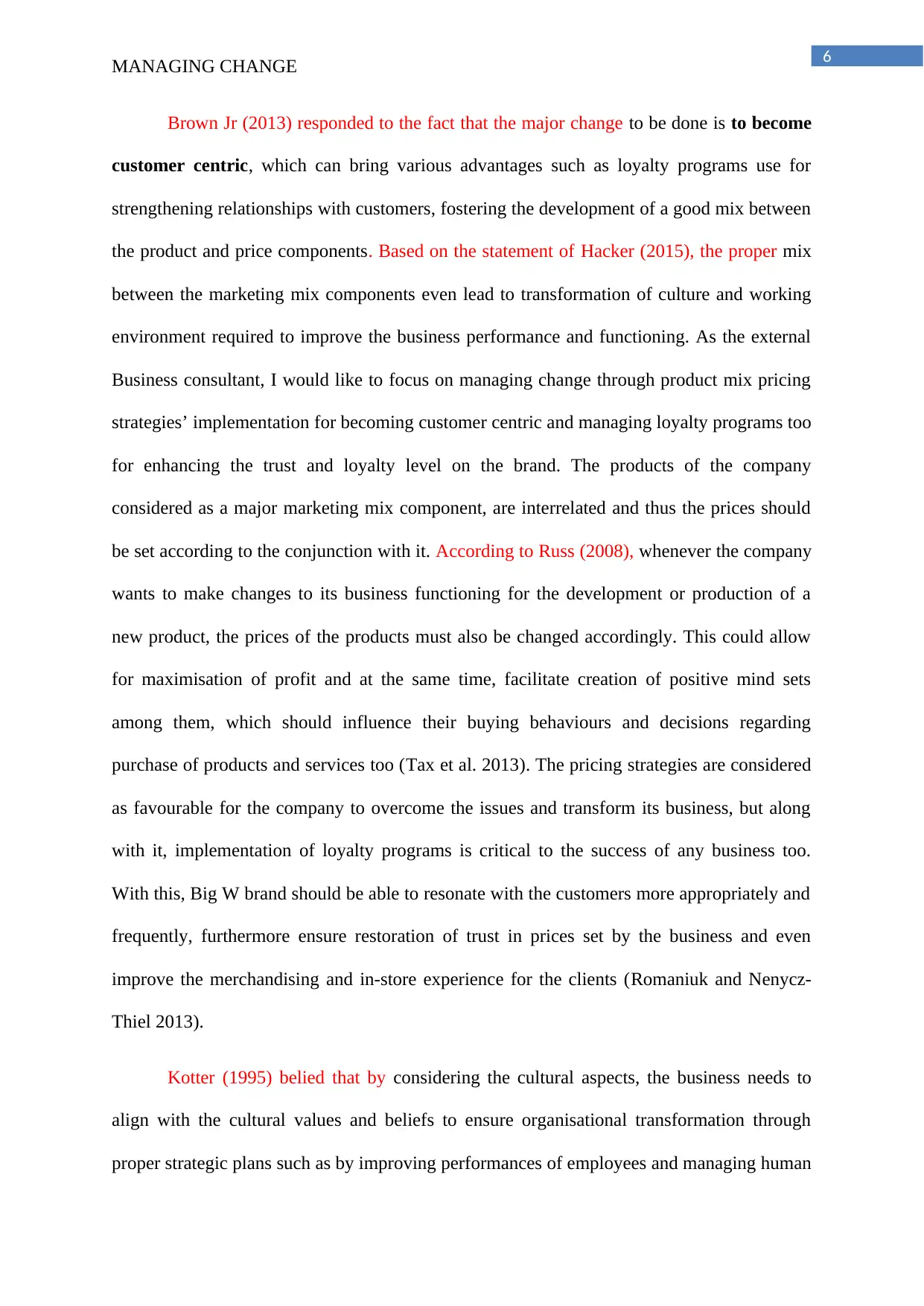
6
MANAGING CHANGE
Brown Jr (2013) responded to the fact that the major change to be done is to become
customer centric, which can bring various advantages such as loyalty programs use for
strengthening relationships with customers, fostering the development of a good mix between
the product and price components. Based on the statement of Hacker (2015), the proper mix
between the marketing mix components even lead to transformation of culture and working
environment required to improve the business performance and functioning. As the external
Business consultant, I would like to focus on managing change through product mix pricing
strategies’ implementation for becoming customer centric and managing loyalty programs too
for enhancing the trust and loyalty level on the brand. The products of the company
considered as a major marketing mix component, are interrelated and thus the prices should
be set according to the conjunction with it. According to Russ (2008), whenever the company
wants to make changes to its business functioning for the development or production of a
new product, the prices of the products must also be changed accordingly. This could allow
for maximisation of profit and at the same time, facilitate creation of positive mind sets
among them, which should influence their buying behaviours and decisions regarding
purchase of products and services too (Tax et al. 2013). The pricing strategies are considered
as favourable for the company to overcome the issues and transform its business, but along
with it, implementation of loyalty programs is critical to the success of any business too.
With this, Big W brand should be able to resonate with the customers more appropriately and
frequently, furthermore ensure restoration of trust in prices set by the business and even
improve the merchandising and in-store experience for the clients (Romaniuk and Nenycz-
Thiel 2013).
Kotter (1995) belied that by considering the cultural aspects, the business needs to
align with the cultural values and beliefs to ensure organisational transformation through
proper strategic plans such as by improving performances of employees and managing human
MANAGING CHANGE
Brown Jr (2013) responded to the fact that the major change to be done is to become
customer centric, which can bring various advantages such as loyalty programs use for
strengthening relationships with customers, fostering the development of a good mix between
the product and price components. Based on the statement of Hacker (2015), the proper mix
between the marketing mix components even lead to transformation of culture and working
environment required to improve the business performance and functioning. As the external
Business consultant, I would like to focus on managing change through product mix pricing
strategies’ implementation for becoming customer centric and managing loyalty programs too
for enhancing the trust and loyalty level on the brand. The products of the company
considered as a major marketing mix component, are interrelated and thus the prices should
be set according to the conjunction with it. According to Russ (2008), whenever the company
wants to make changes to its business functioning for the development or production of a
new product, the prices of the products must also be changed accordingly. This could allow
for maximisation of profit and at the same time, facilitate creation of positive mind sets
among them, which should influence their buying behaviours and decisions regarding
purchase of products and services too (Tax et al. 2013). The pricing strategies are considered
as favourable for the company to overcome the issues and transform its business, but along
with it, implementation of loyalty programs is critical to the success of any business too.
With this, Big W brand should be able to resonate with the customers more appropriately and
frequently, furthermore ensure restoration of trust in prices set by the business and even
improve the merchandising and in-store experience for the clients (Romaniuk and Nenycz-
Thiel 2013).
Kotter (1995) belied that by considering the cultural aspects, the business needs to
align with the cultural values and beliefs to ensure organisational transformation through
proper strategic plans such as by improving performances of employees and managing human
You're viewing a preview
Unlock full access by subscribing today!
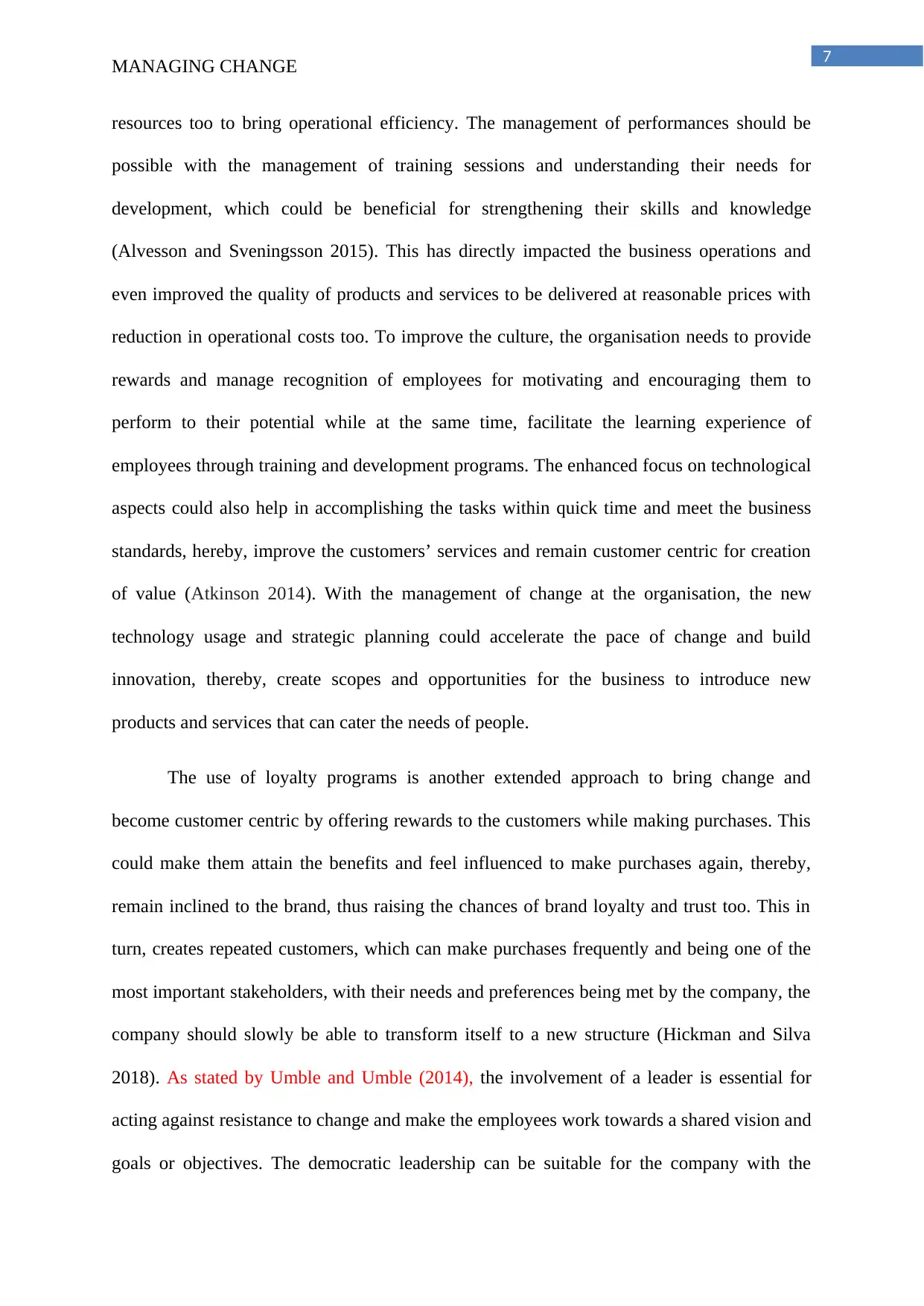
7
MANAGING CHANGE
resources too to bring operational efficiency. The management of performances should be
possible with the management of training sessions and understanding their needs for
development, which could be beneficial for strengthening their skills and knowledge
(Alvesson and Sveningsson 2015). This has directly impacted the business operations and
even improved the quality of products and services to be delivered at reasonable prices with
reduction in operational costs too. To improve the culture, the organisation needs to provide
rewards and manage recognition of employees for motivating and encouraging them to
perform to their potential while at the same time, facilitate the learning experience of
employees through training and development programs. The enhanced focus on technological
aspects could also help in accomplishing the tasks within quick time and meet the business
standards, hereby, improve the customers’ services and remain customer centric for creation
of value (Atkinson 2014). With the management of change at the organisation, the new
technology usage and strategic planning could accelerate the pace of change and build
innovation, thereby, create scopes and opportunities for the business to introduce new
products and services that can cater the needs of people.
The use of loyalty programs is another extended approach to bring change and
become customer centric by offering rewards to the customers while making purchases. This
could make them attain the benefits and feel influenced to make purchases again, thereby,
remain inclined to the brand, thus raising the chances of brand loyalty and trust too. This in
turn, creates repeated customers, which can make purchases frequently and being one of the
most important stakeholders, with their needs and preferences being met by the company, the
company should slowly be able to transform itself to a new structure (Hickman and Silva
2018). As stated by Umble and Umble (2014), the involvement of a leader is essential for
acting against resistance to change and make the employees work towards a shared vision and
goals or objectives. The democratic leadership can be suitable for the company with the
MANAGING CHANGE
resources too to bring operational efficiency. The management of performances should be
possible with the management of training sessions and understanding their needs for
development, which could be beneficial for strengthening their skills and knowledge
(Alvesson and Sveningsson 2015). This has directly impacted the business operations and
even improved the quality of products and services to be delivered at reasonable prices with
reduction in operational costs too. To improve the culture, the organisation needs to provide
rewards and manage recognition of employees for motivating and encouraging them to
perform to their potential while at the same time, facilitate the learning experience of
employees through training and development programs. The enhanced focus on technological
aspects could also help in accomplishing the tasks within quick time and meet the business
standards, hereby, improve the customers’ services and remain customer centric for creation
of value (Atkinson 2014). With the management of change at the organisation, the new
technology usage and strategic planning could accelerate the pace of change and build
innovation, thereby, create scopes and opportunities for the business to introduce new
products and services that can cater the needs of people.
The use of loyalty programs is another extended approach to bring change and
become customer centric by offering rewards to the customers while making purchases. This
could make them attain the benefits and feel influenced to make purchases again, thereby,
remain inclined to the brand, thus raising the chances of brand loyalty and trust too. This in
turn, creates repeated customers, which can make purchases frequently and being one of the
most important stakeholders, with their needs and preferences being met by the company, the
company should slowly be able to transform itself to a new structure (Hickman and Silva
2018). As stated by Umble and Umble (2014), the involvement of a leader is essential for
acting against resistance to change and make the employees work towards a shared vision and
goals or objectives. The democratic leadership can be suitable for the company with the
Paraphrase This Document
Need a fresh take? Get an instant paraphrase of this document with our AI Paraphraser
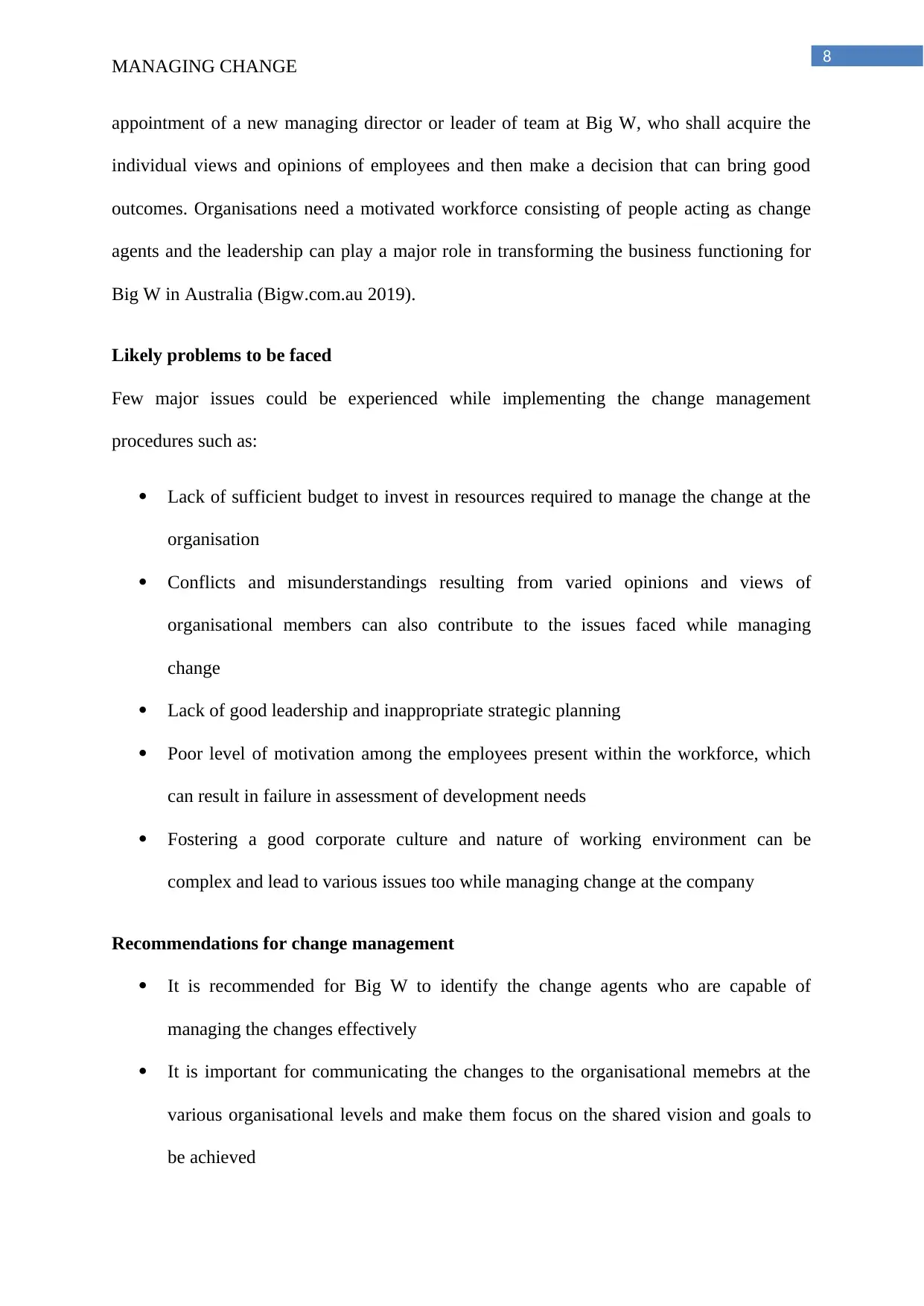
8
MANAGING CHANGE
appointment of a new managing director or leader of team at Big W, who shall acquire the
individual views and opinions of employees and then make a decision that can bring good
outcomes. Organisations need a motivated workforce consisting of people acting as change
agents and the leadership can play a major role in transforming the business functioning for
Big W in Australia (Bigw.com.au 2019).
Likely problems to be faced
Few major issues could be experienced while implementing the change management
procedures such as:
Lack of sufficient budget to invest in resources required to manage the change at the
organisation
Conflicts and misunderstandings resulting from varied opinions and views of
organisational members can also contribute to the issues faced while managing
change
Lack of good leadership and inappropriate strategic planning
Poor level of motivation among the employees present within the workforce, which
can result in failure in assessment of development needs
Fostering a good corporate culture and nature of working environment can be
complex and lead to various issues too while managing change at the company
Recommendations for change management
It is recommended for Big W to identify the change agents who are capable of
managing the changes effectively
It is important for communicating the changes to the organisational memebrs at the
various organisational levels and make them focus on the shared vision and goals to
be achieved
MANAGING CHANGE
appointment of a new managing director or leader of team at Big W, who shall acquire the
individual views and opinions of employees and then make a decision that can bring good
outcomes. Organisations need a motivated workforce consisting of people acting as change
agents and the leadership can play a major role in transforming the business functioning for
Big W in Australia (Bigw.com.au 2019).
Likely problems to be faced
Few major issues could be experienced while implementing the change management
procedures such as:
Lack of sufficient budget to invest in resources required to manage the change at the
organisation
Conflicts and misunderstandings resulting from varied opinions and views of
organisational members can also contribute to the issues faced while managing
change
Lack of good leadership and inappropriate strategic planning
Poor level of motivation among the employees present within the workforce, which
can result in failure in assessment of development needs
Fostering a good corporate culture and nature of working environment can be
complex and lead to various issues too while managing change at the company
Recommendations for change management
It is recommended for Big W to identify the change agents who are capable of
managing the changes effectively
It is important for communicating the changes to the organisational memebrs at the
various organisational levels and make them focus on the shared vision and goals to
be achieved
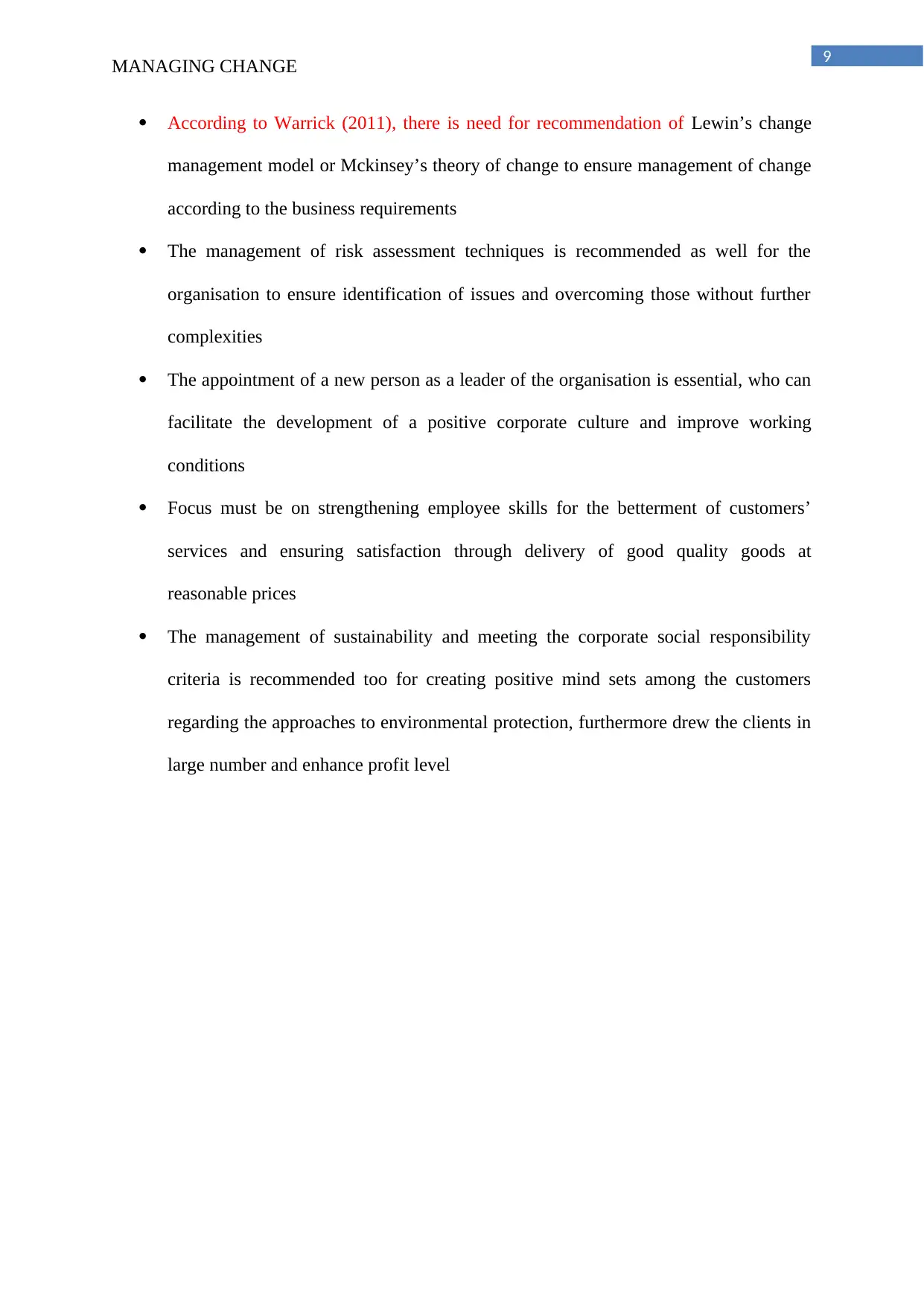
9
MANAGING CHANGE
According to Warrick (2011), there is need for recommendation of Lewin’s change
management model or Mckinsey’s theory of change to ensure management of change
according to the business requirements
The management of risk assessment techniques is recommended as well for the
organisation to ensure identification of issues and overcoming those without further
complexities
The appointment of a new person as a leader of the organisation is essential, who can
facilitate the development of a positive corporate culture and improve working
conditions
Focus must be on strengthening employee skills for the betterment of customers’
services and ensuring satisfaction through delivery of good quality goods at
reasonable prices
The management of sustainability and meeting the corporate social responsibility
criteria is recommended too for creating positive mind sets among the customers
regarding the approaches to environmental protection, furthermore drew the clients in
large number and enhance profit level
MANAGING CHANGE
According to Warrick (2011), there is need for recommendation of Lewin’s change
management model or Mckinsey’s theory of change to ensure management of change
according to the business requirements
The management of risk assessment techniques is recommended as well for the
organisation to ensure identification of issues and overcoming those without further
complexities
The appointment of a new person as a leader of the organisation is essential, who can
facilitate the development of a positive corporate culture and improve working
conditions
Focus must be on strengthening employee skills for the betterment of customers’
services and ensuring satisfaction through delivery of good quality goods at
reasonable prices
The management of sustainability and meeting the corporate social responsibility
criteria is recommended too for creating positive mind sets among the customers
regarding the approaches to environmental protection, furthermore drew the clients in
large number and enhance profit level
You're viewing a preview
Unlock full access by subscribing today!
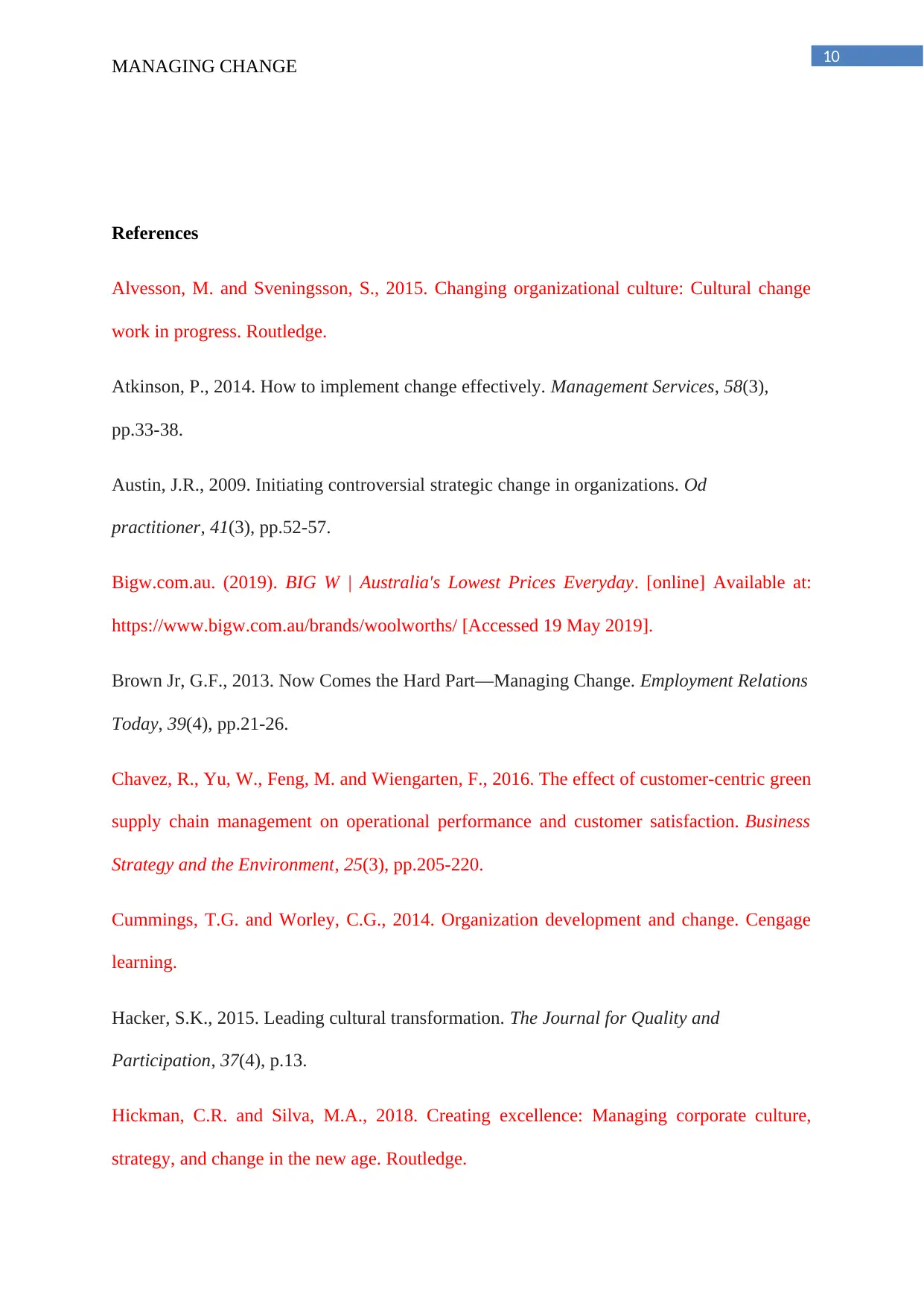
10
MANAGING CHANGE
References
Alvesson, M. and Sveningsson, S., 2015. Changing organizational culture: Cultural change
work in progress. Routledge.
Atkinson, P., 2014. How to implement change effectively. Management Services, 58(3),
pp.33-38.
Austin, J.R., 2009. Initiating controversial strategic change in organizations. Od
practitioner, 41(3), pp.52-57.
Bigw.com.au. (2019). BIG W | Australia's Lowest Prices Everyday. [online] Available at:
https://www.bigw.com.au/brands/woolworths/ [Accessed 19 May 2019].
Brown Jr, G.F., 2013. Now Comes the Hard Part—Managing Change. Employment Relations
Today, 39(4), pp.21-26.
Chavez, R., Yu, W., Feng, M. and Wiengarten, F., 2016. The effect of customer‐centric green
supply chain management on operational performance and customer satisfaction. Business
Strategy and the Environment, 25(3), pp.205-220.
Cummings, T.G. and Worley, C.G., 2014. Organization development and change. Cengage
learning.
Hacker, S.K., 2015. Leading cultural transformation. The Journal for Quality and
Participation, 37(4), p.13.
Hickman, C.R. and Silva, M.A., 2018. Creating excellence: Managing corporate culture,
strategy, and change in the new age. Routledge.
MANAGING CHANGE
References
Alvesson, M. and Sveningsson, S., 2015. Changing organizational culture: Cultural change
work in progress. Routledge.
Atkinson, P., 2014. How to implement change effectively. Management Services, 58(3),
pp.33-38.
Austin, J.R., 2009. Initiating controversial strategic change in organizations. Od
practitioner, 41(3), pp.52-57.
Bigw.com.au. (2019). BIG W | Australia's Lowest Prices Everyday. [online] Available at:
https://www.bigw.com.au/brands/woolworths/ [Accessed 19 May 2019].
Brown Jr, G.F., 2013. Now Comes the Hard Part—Managing Change. Employment Relations
Today, 39(4), pp.21-26.
Chavez, R., Yu, W., Feng, M. and Wiengarten, F., 2016. The effect of customer‐centric green
supply chain management on operational performance and customer satisfaction. Business
Strategy and the Environment, 25(3), pp.205-220.
Cummings, T.G. and Worley, C.G., 2014. Organization development and change. Cengage
learning.
Hacker, S.K., 2015. Leading cultural transformation. The Journal for Quality and
Participation, 37(4), p.13.
Hickman, C.R. and Silva, M.A., 2018. Creating excellence: Managing corporate culture,
strategy, and change in the new age. Routledge.
Paraphrase This Document
Need a fresh take? Get an instant paraphrase of this document with our AI Paraphraser
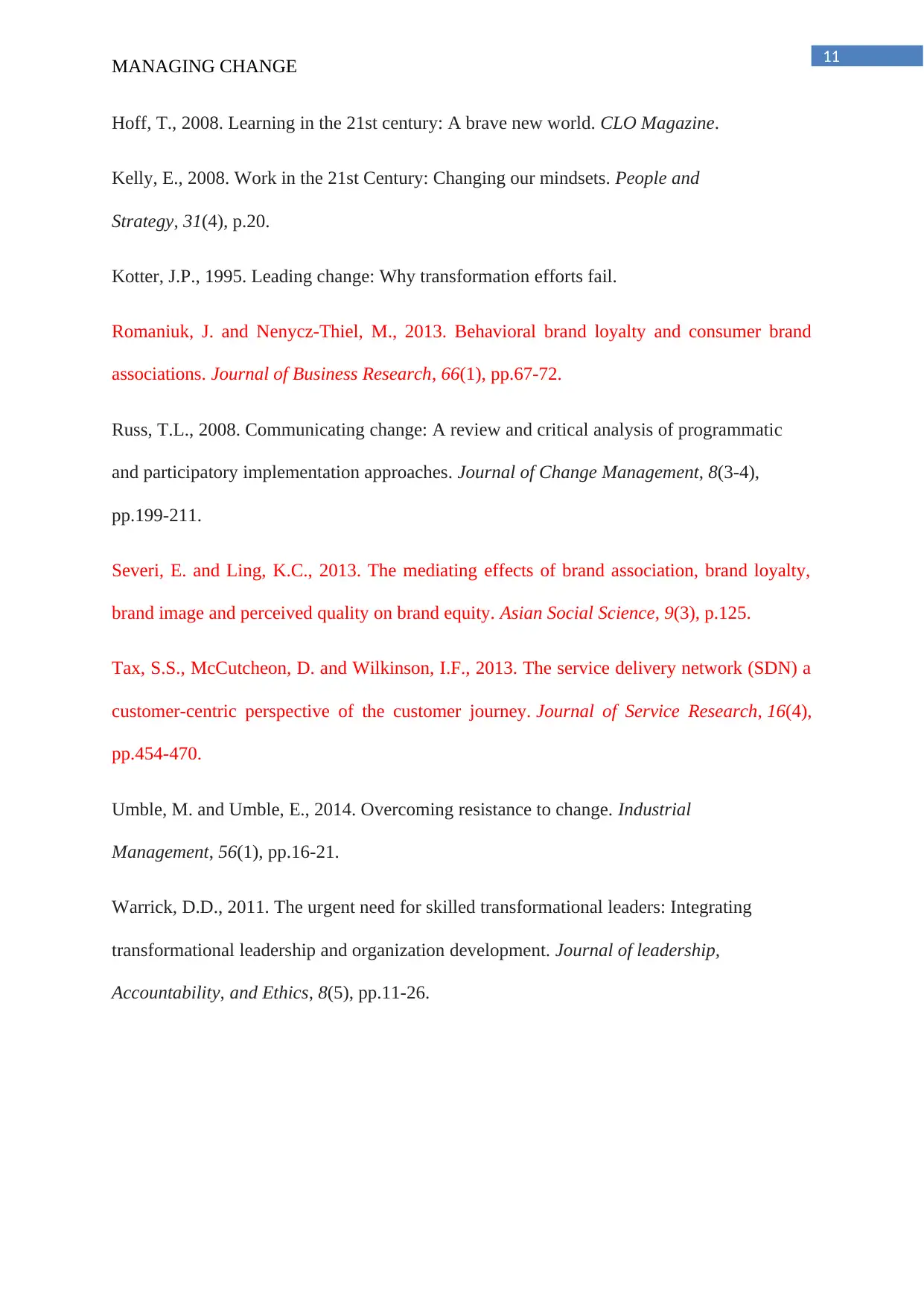
11
MANAGING CHANGE
Hoff, T., 2008. Learning in the 21st century: A brave new world. CLO Magazine.
Kelly, E., 2008. Work in the 21st Century: Changing our mindsets. People and
Strategy, 31(4), p.20.
Kotter, J.P., 1995. Leading change: Why transformation efforts fail.
Romaniuk, J. and Nenycz-Thiel, M., 2013. Behavioral brand loyalty and consumer brand
associations. Journal of Business Research, 66(1), pp.67-72.
Russ, T.L., 2008. Communicating change: A review and critical analysis of programmatic
and participatory implementation approaches. Journal of Change Management, 8(3-4),
pp.199-211.
Severi, E. and Ling, K.C., 2013. The mediating effects of brand association, brand loyalty,
brand image and perceived quality on brand equity. Asian Social Science, 9(3), p.125.
Tax, S.S., McCutcheon, D. and Wilkinson, I.F., 2013. The service delivery network (SDN) a
customer-centric perspective of the customer journey. Journal of Service Research, 16(4),
pp.454-470.
Umble, M. and Umble, E., 2014. Overcoming resistance to change. Industrial
Management, 56(1), pp.16-21.
Warrick, D.D., 2011. The urgent need for skilled transformational leaders: Integrating
transformational leadership and organization development. Journal of leadership,
Accountability, and Ethics, 8(5), pp.11-26.
MANAGING CHANGE
Hoff, T., 2008. Learning in the 21st century: A brave new world. CLO Magazine.
Kelly, E., 2008. Work in the 21st Century: Changing our mindsets. People and
Strategy, 31(4), p.20.
Kotter, J.P., 1995. Leading change: Why transformation efforts fail.
Romaniuk, J. and Nenycz-Thiel, M., 2013. Behavioral brand loyalty and consumer brand
associations. Journal of Business Research, 66(1), pp.67-72.
Russ, T.L., 2008. Communicating change: A review and critical analysis of programmatic
and participatory implementation approaches. Journal of Change Management, 8(3-4),
pp.199-211.
Severi, E. and Ling, K.C., 2013. The mediating effects of brand association, brand loyalty,
brand image and perceived quality on brand equity. Asian Social Science, 9(3), p.125.
Tax, S.S., McCutcheon, D. and Wilkinson, I.F., 2013. The service delivery network (SDN) a
customer-centric perspective of the customer journey. Journal of Service Research, 16(4),
pp.454-470.
Umble, M. and Umble, E., 2014. Overcoming resistance to change. Industrial
Management, 56(1), pp.16-21.
Warrick, D.D., 2011. The urgent need for skilled transformational leaders: Integrating
transformational leadership and organization development. Journal of leadership,
Accountability, and Ethics, 8(5), pp.11-26.
1 out of 11
Related Documents
Your All-in-One AI-Powered Toolkit for Academic Success.
+13062052269
info@desklib.com
Available 24*7 on WhatsApp / Email
![[object Object]](/_next/static/media/star-bottom.7253800d.svg)
Unlock your academic potential
© 2024 | Zucol Services PVT LTD | All rights reserved.




